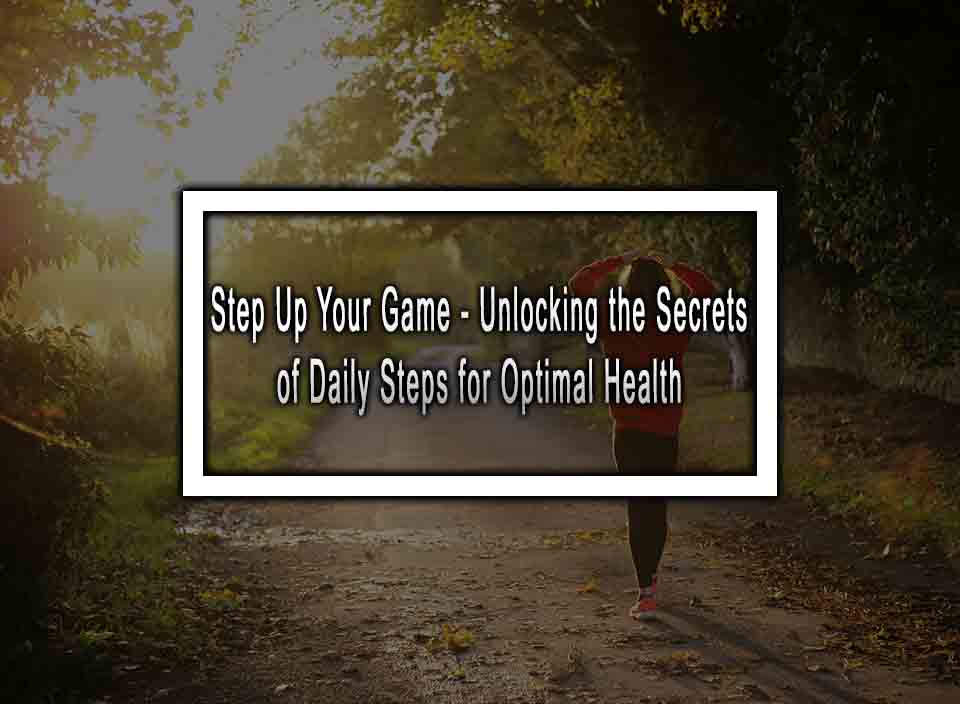Table of Contents
ToggleYour Journey to Wellness Begins With Daily Steps
Are you ready to put your best foot forward and embark on a journey towards a healthier and more active lifestyle? One simple yet powerful way to achieve this is by monitoring your daily steps. Keeping track of how many steps you take each day can have a significant impact on your overall well-being. In this article, we will delve into the importance of daily steps, the recommended number for a healthy lifestyle, and how you can easily incorporate them into your routine.
Understanding the Importance of Daily Steps for Your Well-being
When it comes to leading a sedentary lifestyle, it’s easy to get caught up in the hustle and bustle, neglecting our bodies’ natural need for movement. However, research shows that physical activity, even in small doses, can have a colossal impact on our health. The simple act of walking, measured by the number of steps you take per day, is a fantastic way to stay active and enhance your overall well-being.
Walking is an activity that naturally fits into our daily lives, and its impact on our physical health cannot be underestimated. Regular walking helps strengthen our cardiovascular system, reducing the risk of heart disease, high blood pressure, and stroke. Moreover, it aids in weight management by burning calories, boosting metabolism, and promoting healthy digestion.
Walking also contributes to improved flexibility and joint health. With each step, our joints move, lubricating them and preventing stiffness and pain. Additionally, it supports bone density, reducing the risk of osteoporosis and related fractures. By incorporating a daily step count, we can significantly enhance our physical well-being.
How Many Steps Do I Need a Day to Reap the Health Benefits?
Experts suggest that an adult should strive to achieve a minimum of 10,000 steps per day to promote good health. This number may sound daunting at first, but fear not – you don’t have to jump straight into a 10,000-step routine. Gradual progress and consistency are key. Start by setting achievable goals, gradually increasing your step count week by week. This will help you establish a sustainable habit without overwhelming yourself.
Incorporating Steps into Your Daily Routine
Incorporating steps into your daily routine doesn’t have to be complicated or time-consuming. Here are some fantastic tips to help you effortlessly boost your step count:
1. Take the scenic route: Instead of automatically hopping on the elevator, opt for the stairs whenever possible. This simple change can add a significant number of steps to your daily tally.
2. Park strategically: Park your car farther away from the office, shopping center, or any destination you’re heading to. Those extra steps may seem inconsequential, but they quickly add up over time.
3. Walk and talk: If you find yourself engaged in a phone conversation, utilize the opportunity to walk around. Trekking a few extra steps while engaged in dialogue can help break up sedentary habits and improve overall circulation.
Conclusion
Embracing a physically active lifestyle begins with taking those vital steps towards a healthier you. By aiming to achieve the recommended 10,000 steps daily, you’ll experience an array of benefits, including improved cardiovascular health, increased energy levels, enhanced mood, and weight management. Remember, every step counts, no matter how small. So, put on those walking shoes, set a goal, and stride towards a healthier, happier you – one step at a time.
Unlocking the Secrets of Daily Steps FAQ
Here are the most common questions about unlocking the secrets of daily steps.
1. How accurate are step-tracking devices?
Step-tracking devices vary in accuracy. Pedometers and smartphone apps can provide a general estimate of your steps, but they may not be entirely precise. Fitness trackers tend to be more accurate because they use advanced sensors to track movement. The accuracy also depends on how well the device is worn or carried, as different locations (e.g., wrist, pocket) can affect accuracy.
2. Are all steps equal in terms of health benefits?
While all steps contribute to physical activity, not all steps are equal in terms of intensity and health benefits. Steps taken during vigorous exercise, like running or high-intensity interval training, have more significant health benefits compared to everyday walking. However, every step counts towards increasing your overall physical activity level, so even low-intensity steps have their benefits.
3. How can I increase my daily step count?
There are various ways to increase your daily step count. You can try taking the stairs instead of the elevator, parking your car farther from your destination, going for a walk during breaks, or engaging in recreational activities like dancing or hiking. Setting achievable goals, finding a walking buddy, or joining walking groups can also help to make it more enjoyable and motivating.
4. Are there any risks associated with increasing daily step count?
If you have a sedentary lifestyle or any underlying health conditions, it’s important to consult with a healthcare professional before dramatically increasing your daily step count. While walking is generally a safe form of exercise, overexertion or pushing yourself too hard can lead to injuries. It’s crucial to listen to your body and gradually increase your steps to avoid any potential risks.
5. Can I still benefit from daily steps if I can’t reach 10,000 steps per day?
Absolutely! While 10,000 steps per day is a commonly recommended goal, any increase in your daily steps can still provide health benefits. Even small increases in step count have been shown to improve cardiovascular health and reduce the risk of chronic diseases. The most important thing is to focus on being more active and finding ways to incorporate more movement into your daily routine.












